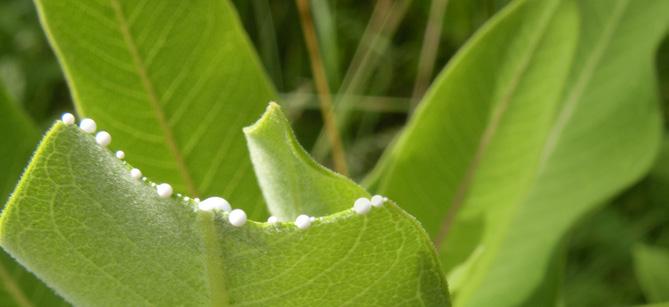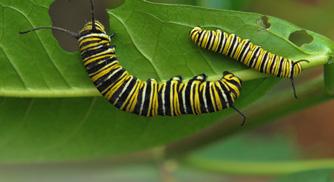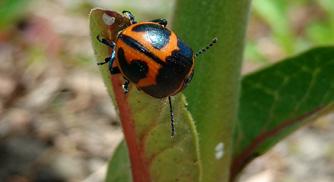
2 minute read
THE SMALL WORLD OF MILKWEED
• BY MARIE-EVE ANDRÉ AND LUCILE PIC
Over the course of their evolutionary history, plants and insects have woven close relationships. Milkweed, of which there are a dozen or so species in Canada, is an amazingly effective plant in the way it adapts to curb the impact of herbivores on its growth. Sticky latex, toxic molecules—every means possible is used to avoid being eaten! In turn, some insects have adapted to foil its defences. This is how milkweed and its mini-community influence each other: a complex co-evolution that has developed over millions of years.
LATEX
As a means of protection, milkweed produces a sticky, viscous latex that oozes out copiously at the slightest harm to its leaves or stems. For example, if a milkweed plant is gnawed by an insect, an abundant flow of latex immediately leaks out onto the plant-eater, sticking to its mandibles or legs—making it hard for the insect to really chow down! As a result, many insects simply opt to look elsewhere for their next meal.

PHOTO Espace pour la vie (Sonya Charest)
TOXIC COMPOUNDS
Milkweed tissue contains toxic compounds called “cardenolides.” Besides their bitter taste, these molecules have unpleasant effects on animals that ingest them: heart palpitations, nausea, slower growth, etc. Cardenolides are found in various concentrations in several parts of the plant, from the roots to the leaves, by way of the stems. But it’s the latex that contains the most! That’s what makes it even more effective at repelling leaf-eaters.
DISPLAYING THEIR COLOURS
Insects that build up cardenolides in their bodies often display bright colours and bold patterns featuring stripes or spots. This so-called “aposematic” colouration warns potential predators about their toxicity. Predators quickly learn to recognize these insects’ conspicuous colours and avoid them.

PHOTO André Sarrazin
ADAPTING TO TOXICITY
Some insects have developed a resistance to toxic compounds. They tolerate cardenolides and suffer relatively few physiological effects after ingesting them. What’s more, some insects absolutely love milkweed and eat only that. One example is the monarch caterpillar, but there are also a few other insects, such as the milkweed leaf beetle, the common milkweed beetle and the milkweed tussock moth or milkweed tiger moth. In fact, these insects even store cardenolides in their own bodies so they themselves become toxic to predators. As a result, they both feed and protect themselves from predators at the same time.

PHOTO André Sarrazin

PHOTO Espace pour la vie (Sonya Charest)
NECTAR
The nectar of milkweed flowers contains a low concentration of cardenolides. It is therefore consumed by a greater number of species than the leaves. Generalist pollinators like bumblebees visit milkweed flowers from time to time. Adult monarchs also feed on milkweed nectar, but unlike their caterpillars, not exclusively on milkweed. Adults can thus be seen foraging for nectar on a wide range of other flowers.

PHOTO André Sarrazin
SET OFF ON A MISSION!
Would you like to learn more about this plant and the surprising community of insects that lives off it? Take part in Mission Monarch! It’s a participatory science program coordinated by the Insectarium. It involves finding milkweed plants, counting the monarch eggs and caterpillars on them and recording your observations on mission-monarch.org. It’s easy, fun and extremely useful for the study of monarch reproduction. The observational data you record will help scientists gain a better understanding of the breeding habitat of this iconic butterfly.










